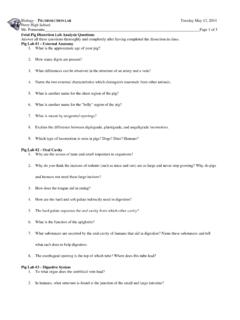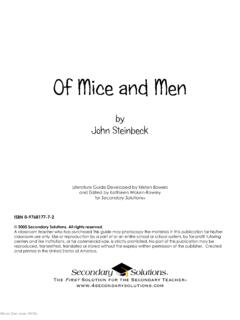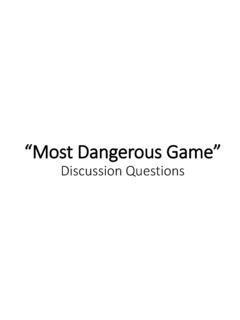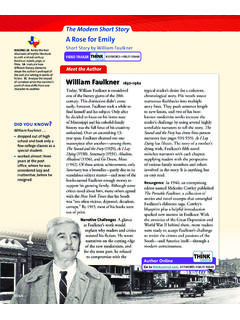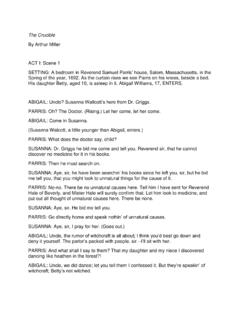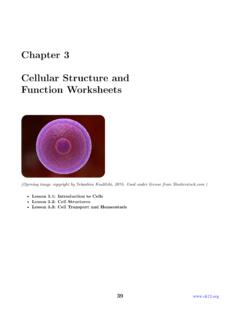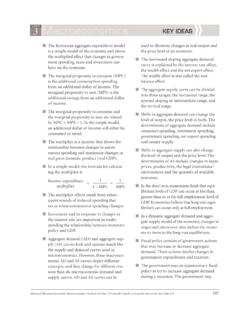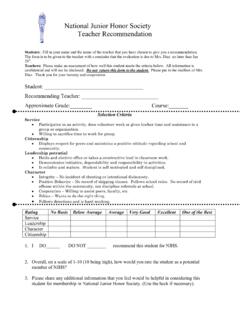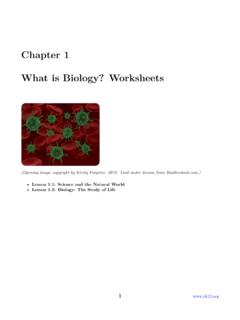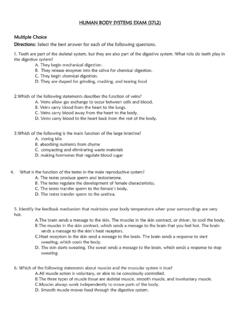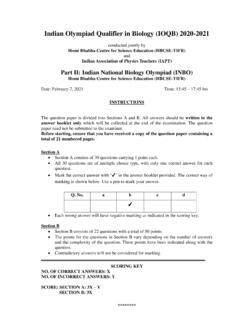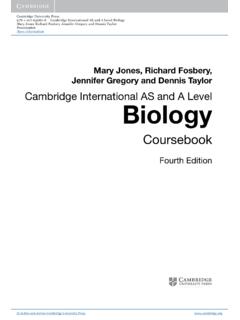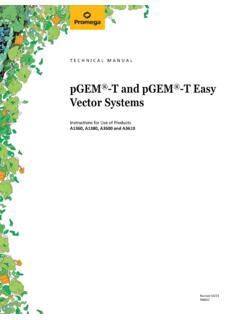Transcription of Chapter 2 The Chemistry of Life Worksheets
1 Chapter 2 The Chemistry of LifeWorksheets(Opening image courtesy of David Iberri, , and underthe Creative Commons license CC-BY-SA ) Lesson : Matter and Organic Compounds Lesson : Biochemical Reactions Lesson : Water, Acids, and and Organic CompoundsLesson : True or FalseName_____ Class_____ Date_____Write true if the statement is true or false if the statement is 1. An atom is smaller than an 2. Organic compounds are found in living 3. Proteins are made out of amino 4. Proteins speed up chemical 5. The DNA code carries instructions for the correct sequence of nucleic acids in a protein_____ 6. Sugars and phosphate groups form the middle of a nucleic acid 7. DNA (and RNA) is made out of 8. A protein consists of one or more polypeptide 9. Lipids include fats, oils, and 10. Carbohydrates are the most common type of organic 11. Peanut oil is an unsaturated fatty 12. Cytosine and adenine are complementary bases in 13. A double helix is like a spiral 14.
2 Phospholipids form cell 15. Carbohydrates are made out of : Critical ReadingName_____ Class_____ Date_____Read these passages from the text and answer the questions that Significance of CarbonA compound found mainly in living things is known as anorganic compound. Organic compounds makeup the cells and other structures of organisms and carry out life processes. Carbon is the main elementin organic compounds, so carbon is essential to life on Earth. Without carbon, life as we know it couldnot exist. Why is carbon so basic to life? The reason is carbon s ability to form stable bonds with manyelements, including itself. This property allows carbon to form a huge variety of very large and complexmolecules. In fact, there are nearly 10 million carbon-based compounds in living things! However, themillions of organic compounds can be grouped into just four major types: carbohydrates, lipids, proteins,and nucleic acids. You can compare the four types Each type is also described :Types of Organic CompoundsType of CompoundExamplesElementsFunctionsCarbohy dratessugars, starchescarbon, hydrogen, oxy-genprovides energy to cells,stores energy, formsbody structuresLipidsfats, oilscarbon, hydrogen, oxy-genstores energy, formscell membranes, carriesmessagesProteinsenzymes, antibodies carbon, hydrogen, oxy-gen, nitrogen, sulfurhelps cells keep theirshape, makes up mus-cles, speeds up chemicalreactions, carries mes-sages and materialsNucleic AcidsDNA, RNAcarbon, hydrogen, oxy-gen, nitrogen, phospho-ruscontains instructions forproteins, passes instruc-tions from parents tooffspring, helps makeproteinsCarbohydratesCarbohydrates are the most common type of organic compound.
3 Acarbohydrateis an organic compoundsuch as sugar or starch, and is used to store energy. Like most organic compounds, carbohydrates are builtof small, repeating units that form bonds with each other to make a larger molecule. In the case ofcarbohydrates, the small, repeating units are called an organic compound such as fat or oil. Organisms use lipids to store energy, but lipids haveother important roles as well. Lipids consist of repeating units called fatty acids. There are two types offatty acids: saturated fatty acids and unsaturated fatty an organic compound made up of small molecules calledamino acids. There are 20 differentaminoacidscommonlyfoundinthepro teinsoflivingthings. acids, whereas large proteins may contain thousands of amino AcidsAnucleic acidis an organic compound, such as DNA or RNA, that is built of small units called nu-cleotides. Many nucleotides bind together to form a chain called apolynucleotide. The nucleic acidDNA(deoxyribonucleic acid) consists of two polynucleotide chains.
4 The nucleic acidRNA(ribonucleicacid) consists of just one polynucleotide List two functions of organic Which two categories of organic compounds store energy? Which of these organic compounds is morecommon?3. What is a main difference between DNA and RNA?4. Describe a difference between large and small Why is carbon considered the essential element of life? : multiple ChoiceName_____ Class_____ Date_____Circle the letter of the correct (H2O) is a(n)(a)element.(b)atom.(c)compound.(d) process that changes some chemical substances into others is a(a)chemical bond.(b)chemical reaction.(c)chemical equation.(d)chemical main difference between saturated and unsaturated fatty acids is(a)the amount of energy found in the fatty acid.(b)saturated fatty acids are liquids.(c)unsaturated fatty acids can be packed together very tightly.(d)the number of hydrogen atoms bonded to the carbon function of proteins can include(a)helping cells keep their shape.(b)helping to destroy foreign substances.
5 (c)speeding up biochemical reactions.(d)all of the characteristics of DNA includes which of the following?(a)DNA is made of nucleotides consisting of a sugar, a phosphate group, and a carbon base.(b)DNA is made of a single polynucleotide chain, which winds into a double helix.(c)DNA is how inherited characteristics are passed from one generation to the next.(d)all of the category of organic compound is the major component of cell membranes?(a)carbohydrate(b)lipid(c)prot ein(d)nucleic cell wall of plants is made out of(a)starch.(b)glycogen.(c)cellulose.(d) main element of organic compounds is(a)hydrogen.(b)oxygen.(c)nitrogen.(d) : Vocabulary IName_____ Class_____ Date_____Match the vocabulary word with the proper 1. an organic compound that stores energy, forms cell membranes, carries messages_____ 2. an organic compound that contains instructions for proteins_____ 3. an organic compound that provides energy to cells, stores energy, forms body structures_____ 4.
6 An organic compound that helps cells keep their shape_____ 5. a pure substance, like carbon_____ 6. may contain just a few simple sugars or thousands_____ 7. subunit that make up proteins_____ 8. subunit used to make nucleic acids_____ 9. lipid in which carbon atoms are bonded to as many hydrogen atoms as possible_____ 10. lipid in which carbon atoms are bonded to groups of atoms other then hydrogen_____ 11. the major component of cell membranes_____ 12. anything that takes up space and has massTermsa. amino acidb. carbohydratec. DNAd. elemente. lipidf. matterg. nucleotideh. phospholipidi. polysaccharidej. proteink. saturated fatty acidl. unsaturated fatty : Vocabulary IIName_____ Class_____ Date_____Fill in the blank with the appropriate A substance that consists of two or more elements is a The information in _____ is passed from parents to offspring when organisms _____ are proteins which bind to foreign substances such as bacteria and target them _____ compounds make up the cells and other structures of organisms and carry out_____ _____ is the monosaccharide used for energy by the cells of most _____ are the most common type of organic _____ is a protein that binds with oxygen The shape of DNA is that of a _____ is used by plants to store _____ is used by plants to form rigid walls around DNA contains _____ instructions for proteins, and _____ helps assemblethe Matter is anything that takes up space and has : Critical WritingName_____ Class_____ Date_____Thoroughly answer the question below.
7 Use appropriate academic vocabulary and clear and the main functions of each of the four classes of organic ReactionsLesson : True or FalseName_____ Class_____ Date_____Write true if the statement is true or false if the statement is 1. A substance that forms as a result of a chemical reaction is called a 2. Only some chemical reactions need energy to get 3. Biochemical reactions take place inside the 4. A chemical reaction that releases heat is an exothermic 5. Most biochemical reactions need help to get 6. Anabolic reactions give off 7. Metabolism is the sum of all the biochemical reactions in an 8. In a chemical reaction, the quantity of an element may 9. During a chemical reaction, some bonds break and new bonds 10. Activation energy is the energy needed to start a chemical 11. An enzyme speeds up the reaction by lowering the activation 12. In a chemical reaction, the number of atoms on one side of the arrow may differ from thenumber of atoms on the other 13.
8 Matter is always 14. Understanding Chemistry is needed to understand fully the processes within the 15. In a chemical reaction, the quantity of each element does not : Critical ReadingName_____ Class_____ Date_____Read these passages from the text and answer the questions that Reactions and EnzymesBiochemical reactionsare chemical reactions that take place inside the cells of living things. Biochem-istry is a relatively new field that emerged at the interface of biology and Chemistry . Its emergence showsthat knowledge of Chemistry as well as biology is needed to understand fully the life processes of organismsat the level of the cell. The sum of all the biochemical reactions in an organism is calledmetabolism. Itincludes both exothermic and endothermic of Biochemical ReactionsExothermic reactions in organisms are calledcatabolic reactions. These reactions break down moleculesinto smaller units and release energy. An example of a catabolic reaction is the breakdown of glucose,which releases energy that cells need to carry out life processes.
9 Endothermic reactions in organisms arecalledanabolic reactions. These reactions build up bigger molecules from smaller ones. An example ofan anabolic reaction is the joining of amino acids to form a protein. Which type of reactions catabolicor anabolic do you think occur when your body digests food?EnzymesMost biochemical reactions in organisms need help in order to take place. Why is this the case? Forone thing, temperatures are usually too low inside living things for biochemical reactions to occur quicklyenough to maintain life. The concentrations of reactants may also be too low for them to come togetherand react. Where do the biochemical reactions get the help they need to proceed? The help comes a protein that speeds up a biochemical reaction. An enzyme works by reducing the amountof activation energy needed to start the reaction. Less activation energy is needed when the correct enzymeis present than when it is not are involved in most biochemical reactions, and they do their job extremely well.
10 A typicalbiochemical reaction could take several days to occur without an enzyme. With the proper enzyme, thesame reaction can occur in just a split second! Without enzymes to speed up biochemical reactions, mostorganisms could not survive. The activities of enzymes depend on the temperature, ionic conditions, andthe pH of the surroundings. Some enzymes work best at an acidic pH, while others work best in What is an enzyme?2. How are biochemistry and metabolism related?3. Which type of reactions catabolic or anabolic do you think occur when your body digests food? How do enzymes work?5. What is activation energy? : multiple ChoiceName_____ Class_____ Date_____Circle the letter of the correct in the burning of methane include(a)CH4and 2O2.(b)CO2and 2H2O.(c)CH4and CO2.(d)CO2and of enzymes depend on(a)pH.(b)temperature.(c)ionic conditions.(d)all of the enzyme is a _____.(a)carbohydrate(b)lipid(c)protein( d)nucleic that take place inside cells are(a)cellular reactions.
